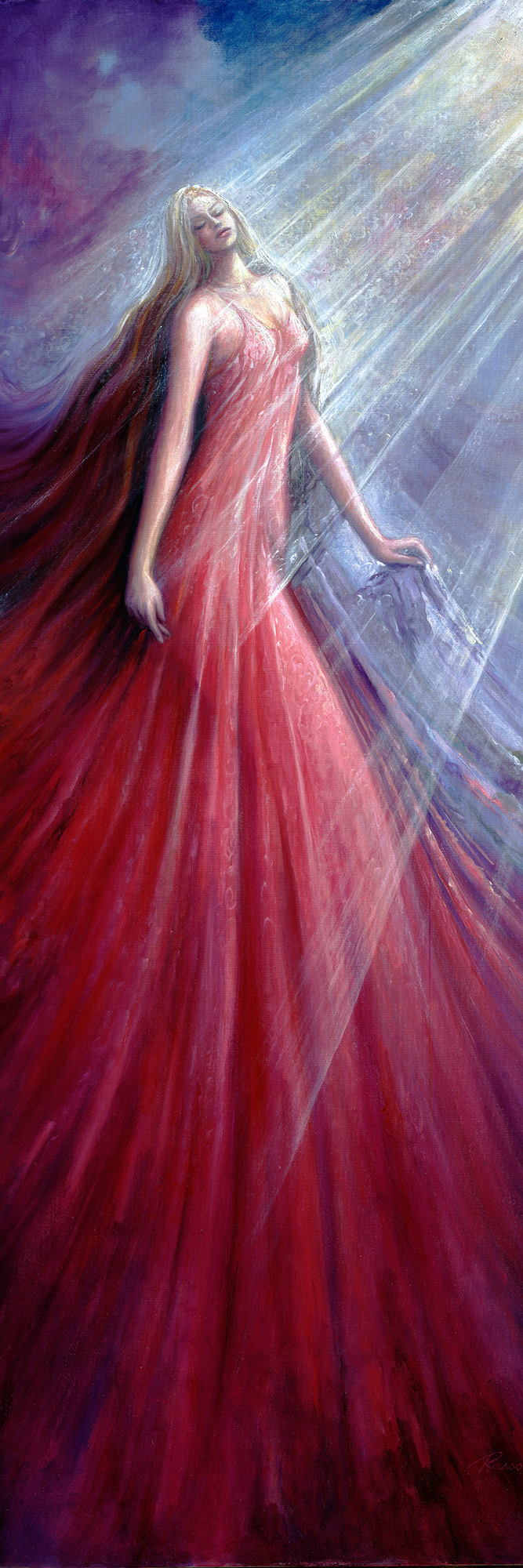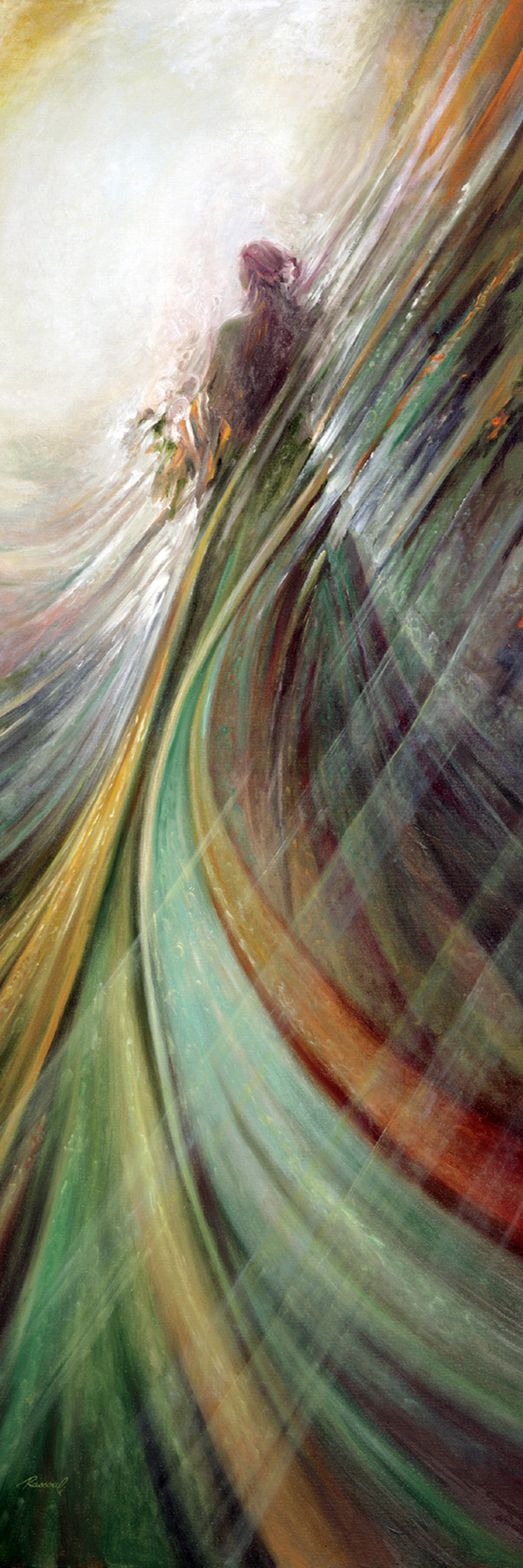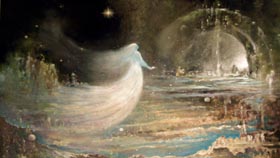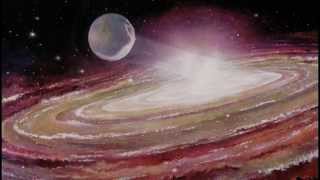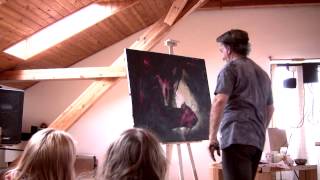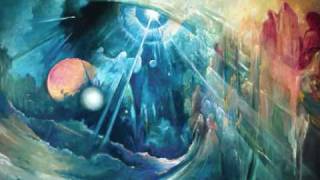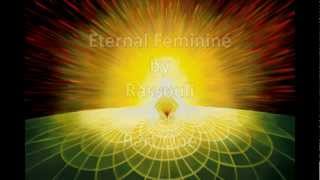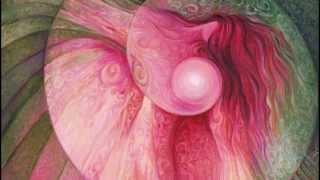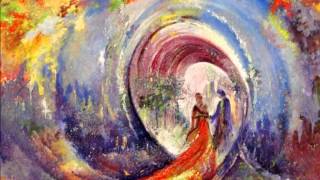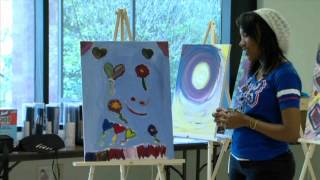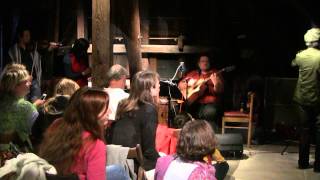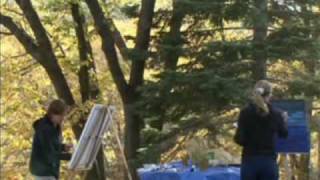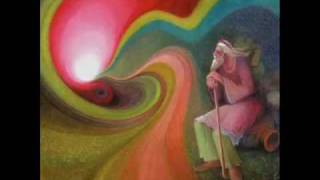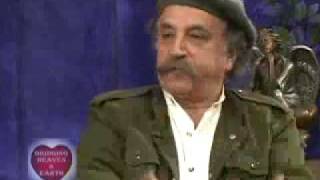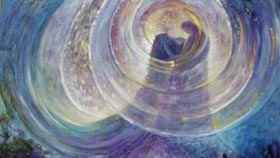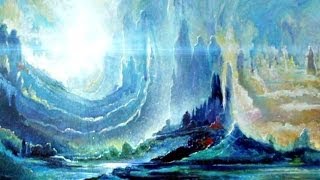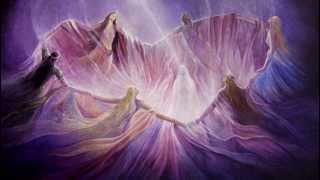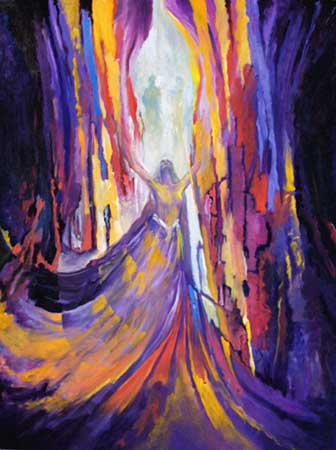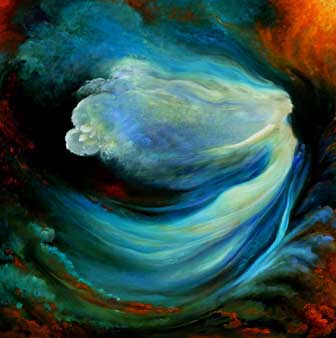|
Fusionartist, Mystic
Painter, Author and Teacher
Gazing at any of Fusionartist Rassouliís creative
works provides a glimpse into the mystic
loving eye with which he looks at the world.
Rassouli has been a celebrated and
innovative painter since childhood who later
trained as an architect. Born in Isfahan,
Iran, and currently living in Southern
California, Rassouli has developed an
artistic style known as Fusionart. He feels
this art form is an expression of cosmic
unity, a coming together of mysticism and
artistic expression.
The development of
Fusionart has
been his entire lifeís work, initiated in
his childhood influenced by the historic and
gorgeous home he grew up in, a mystic uncle
and hours watching the whirling dervishes
spin. Fusionart
and his paintings blur the line between
dream and reality Ė intentionally, since
Rassouli sees the two as coexisting.
Rassouli is a
prolific artist who has exhibited in solo
and group shows worldwide. His work has
appeared in and on the covers of a long list
of publications and the Agape International
Spiritual Center has showcased his
paintings. Inspirations
of the Heart is his most recent
book; it contains a fusion of Rassouliís evocative
art with Reverend Michael Bernard Beckwithís
meditative musings. Rassouli also creates
murals in public space and one of his more
recent, titled Angel of Unity, can be seen
by people walking at the ocean end of
Washington Avenue in Venice. The Angel, like
many of the women Rassouli paints, is
radiant, flowing, like the breath of the
cosmos herself.
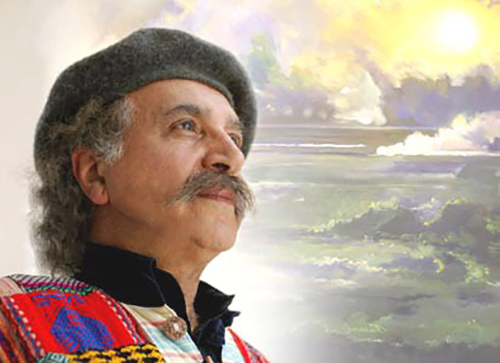
Freydoon Rassouli
Understanding Rassouli's view on
life, love and painting may come best from
his own words. He started his interview with
Los Angeles magazine by talking about
his painting Eternal Sun.
Rassouli: Scientists
were male so they call it the Big Bang.
But what does Big Bang mean? Somebody hit
something and a Big Bang happened? The
truth is that it was a Big Birth. It was
the divine feminine power that gave birth
to the universe. We have the masculine
power and we have the feminine power and
theyíre in complete balance. Itís just
like darkness and light. Theyíre
completely opposite of each other and they
coexist. Life is the union of opposites.
Kerri Blackstone: Do problems and
chaos come to be because the powers are out
of balance?
Rassouli: Chaos and problems
are judgments. The truth is the chaos,
problems, potential Ė all of this is one.
The union of opposites. Is a sunset
beautiful? Is a sunset ugly? A sunset is a
sunset. Itís the way we see it that makes it
beautiful or ugly. If you were to be
executed at sunset, the sunset would be ugly
to you. Why does the sun shine? It doesnít
have any reason. We must accept that the
darkness and the light co-exist. One cannot
destroy each other.
KB: Sometimes it feels
like we have an obligation to fight against
the darkness. What do you say to people who feel that
accepting something, maybe a bad thing, is
the same as giving in to it?
R: There are two ways
of fighting. One is to retaliate; the other
is to prevent the attack. To prevent is
absolutely necessary which means we have to
become enough to face that opposition. If
Iím mad at somebody because they destroyed
something that I had, then Iím going to be
attacking them out of retaliation. That is
what is not right.
KB: By attacking out
of retaliation, weíre just causing more hate
and anger instead of trying to solve the
problem?
R: Right. Instead I
develop myself so that Iím able to face it.
Iím working on a book that is about how we
can become empowered through the opposition.
I talk about the power of limits. We think
limits limit us but itís the limits that
make an artist begin to express herself.
KB: When weíre given
limits Ė creatively, financially or
personally Ė they force us to become even
more creative in order to get around them
and reach our goals. Maybe those limits that
seem like a bad thing, actually are helping
us go further than we might have gone
without them?
R: Exactly. It is the
union of the two Ė the body and the soul.
The spirit and the body have become one and
thatís how we create. Imagine if existence
were just gases Ė hydrogen, oxygen Ė it
wouldnít have any meaning. The union of
these things together Ė the outside and the
inside Ė gives it meaning, like a balloon.
The air and the skin of the balloon together
make the balloon. The air without the skin
would expand to infinity. The skin without
the air would be a piece of rubber that we
usually bury six feet under. That air is the
soul, infinite, no limits. The skin is the
body that the soul goes into and gives it
form.
KB: Do you believe the
soul is eternal? Is it something that has
always been there and then it comes into our
bodies for a time to allow us to create in
this form and then returns to being
infinite?
R: Soul is the flow.
Soul is energy. It has no identity, no
personality. Imagine the soul is a river
thatís flowing. Whateverís inside that river
isnít aware of anything; itís just in the
flow. But then it comes into a little brook
and it ends up somewhere, like a dead end.
That part of the river that is inside the
brook is us. That part of the river is not
happy and it wants to join the flow. If it
has big high rocks or mountains around it,
it gets trapped and canít get back to the
river. If it doesnít have any of these, then
it finds its way back.
KB: What are the rocks
and edges in our lives? Fears, doubts and
limits we put on ourselves?
R: No, those rocks and
edges are our culture, heritage, upbringing,
education, what our mothers taught us from
childhood, what teachers tell us, what
society tells us, what our religion tells
us, what everything tells us. The more weíve
learned, the more difficult it is for our
spirit to get back to the flow.
KB: That makes it
sound like learning is a bad thing that
keeps us separated from our true nature.
R: Learning is not a
bad thing or a good thing. Education is one
thing, training is something else. Learning
(or education) is to unify us. You and I
read the same book, 30,000 people read the
same book, three
million people see the same movie or listen
to the same lecture. Thatís one side. On the
other side, training is to individualize us.
KB: By training, do
you mean doing what we need to do to prepare
for our profession?
R: I mean doing what
you love to do. Doing what you love to do
has nothing to do with your education. You
might love to cook or you might love to
meditate. Developing yourself to do what you
love, developing your deepest self Ė thatís
the training. Education and training have to
work together for us, for the individual.
KB: A lot of people
today feel stuck inside a consumer lifestyle
where weíre convinced we need to spend our
lives working for the things that will
supposedly make us happy. They follow that
path but at the end of the day, thereís no
meaning to it. How do we get away from that?
R: We have to accept
it. Accepting it means bringing it into our
life. We adjust ourselves to the night.
Weíre not saying night is bad or night is
good. We accept it and we deal with it. I
could yell and scream at night forever, ďWhy
are you here? Iím going to destroy you! Iím
going to blow you up!Ē I could do that but
the truth is we have to live with night.
This is not a matter of destroying day or
night. Itís a matter of living with both.
Yoga is finding a balance between my
physical being and my spiritual being.
KB: Do you feel like
you were born an artist or is it something
that developed as you were going through
your training and education?
R: First, letís
define artist. I donít consider myself a
painter. I am an artist. Art is a verb. Art
is bringing the two together. Art is about
union. So when you say ĎIím art-ingí, thatís
bringing the two hearts together.
Imagine a necklace
of pearls. Each pearl has two holes for the
string to go through. This pearl is called
heart. If my pearl does not have a hole, the
string is not going to go through it. The
string that goes through these pearls is
what we call love. Some call it God. Michael
Beckwith calls it Agape, which is a Latin
word for unconditional love.
Now if there is
only one hole, the string is going to go in
there and stop. Thereís got to be another
hole for that string to come out in order
for the necklace to be formed Ė the union of
the pearls Ė which is what Iím calling
Ďheart-stormingí. The medium that does that
is God or love or Yoga Ė which are all the
same.
KB: Are we all born
with two holes in our pearl? If so, what
causes one of both of these holes to get
blocked along the way?
R: Weíre all born
with the two holes but very quickly we begin
to lose the child within us. We begin to not
use the holes so they get rusty and pretty
soon, they close.
Itís the same as
the blood that goes through the heart. The
mystics call it the wine. That wine or blood
goes into your heart, gets purified and
comes back out. The same thing happens with
love. Weíve got to put love into everything
we do in order to experience that pure
oneness, to develop that unity, to be part
of that Yoga. Just like this magazine which
is called Los Angeles Yoga: the union of the
angels.
KB: Why do you think
some people are able to realize that God is
inside of them, when most spend their time
searching for God in the external world or
some other dimension?
R: Because I am a
mystic, I know that God is inside of me.
Whenever I need to ask something, I ask my
heart, ďWhat do I do nextĒ and my heart
tells me what to do. Nobodyís heart is ever
wrong. Even when it seems to be going the
wrong way, it is going the right way.
KB: How are we able to
tell the difference between what our heart
and what our rational mind is telling us
based on what weíve learned and been
conditioned to believe?
R: The soul is on
Earth to enjoy it. The tree is doing its
treeing because it enjoys treeing. The roots
are rooting, the branches are branching, the fruit is
fruiting. Theyíre not thinking about
anything but loving what theyíre doing.
The tree is making
love all the time Ė whether its winter or
fall, it is still making love. ĎGod-ingí is what we call
love. To ĎGodí means loving because thatís
what God does Ė loves. We are created to
enjoy every moment, to be the creator, to
love. God has made us to be God. The whole
idea for us is to love.
We have this
rational mind for the protection of the
body, thatís it. Without the rational mind,
I might walk into the street and a car hits
me, or I walk into a wall or I go outside in
the winter and catch cold. My soul doesnít
need protection Ė my soul is connected with
my heart. If my mind wants to decide for my
heart, itís going to be wrong. And if my
heart wants to decide for my mind, itís
going to be wrong as well. The two have to
work together.
On Sundays early in
the morning, I climb the mountain in the
dark, sit on the peak of the mountain and
wait for the sun to come. I love walking in
the dark because mystery is the essence of
creativity. Without mystery there would not
be artists or scientists Ė itís the mystery
that attracts us. I watch the transition
from darkness to light, from cool to warm,
from blues into yellows. I watch and I
meditate. I am asking the Sun, my creator to
wash away all the darkness inside me,
whatever has captured me this last week. I
go through my complete Yoga, knowing Iím
being cleansed in the process. I have become
one with everybody and everything Ė
mountains, sea, sky.
In that waiting for the beloved to appear, I
experience true union. That is the unity
that prayer brings to us; that Yoga brings
to us. Then I come to my studio and begin to
paint.
KB: Do you feel youíre
still in a trance and/or meditative state
when you come down from the mountain and
start painting? How do you keep yourself
into that state?
R: Oh yes. But it
depends. Whenever I feel good, I paint and
whenever I paint, I feel good. I donít paint
to make a painting. When I paint Iím
dancing. And as Iím playing with paint, I
begin to fly. Iím conscious, but Iím not
aware of what Iím doing.
Thatís the problem
with people who use external means of
getting high. When youíre using internal
means of being high, itís empowering, and
the next morning you can build up on it. If
I drink and get drunk, in those moments it
feels good but next morning itís a problem
because Iím down again. If I get high from
my inner being, the next morning I build up
on it and get even higher. Every painting I
do is in a different zone and at a different
level than the one before. Everything keeps
building up so Iím transforming constantly.This is
how you can judge a work of an artist. Does
the work come from a divine power or someone
who is under an external influence?
KB: Itís fairly common
for people, especially in the arts and
music, to try to reach that trance state
through the external influence of drugs and
alcohol. How can they begin to find
inspiration from an internal high instead?
R: Again, itís the
relationship of creation and destruction.
The creative one puts things out there and
the editor is the destroyer who takes things
away. If the editor leads the way, youíre in
trouble because it shuts off the process
before it even starts. This happens with
many artists, they start editing themselves
before they begin to create. It took Brahms
twenty-five years to compose his first
symphony because he was comparing himself to
Beethoven.
KB: How do we keep our
editor on the sidelines until itís his time
to help?
R: Leila, creation and
destruction, is going to take place at the
same time. If you watch me paint, Iím
creating at the canvas, and then I stand
back and the editor can see, then Iím back
at the canvas and painting. Iím in the
trance state this whole time and the editor
is well trained to do his job. Itís like
when youíre driving. Your driver is your
editor. Youíre in your own world, putting
lipstick on, talking on the phone, thinking
about your day, but the driver is your
editor. The editor knows how to handle
things without hurting the creative being.
Letís say I take the pink brush and put some
pink paint here, at the same time, Iím
destroying the blue paint that was
underneath. I am destroying and creating at
the same time.
KB: When youíre in the
trance, creating and editing a painting, do
you have an idea or vision in your mind of
what the end product will be?
R: Not at all. Actually,
when Iím painting, a lot of times, I will
turn the canvas upside down and work from
that perspective and the painting becomes
something totally different. I do this
with students at my workshops and they see
that what they were painting was an entire
landscape that they didnít even see.
KB: When you teach,
how do you help people get themselves into
the trance state so that their creative
energy can start to flow?
R: Itís always
different. Sometimes, I have them close
their eyes, get close to the canvas and
paint without looking at the canvass. I tell
them, ďIf you open your eyes, your painting
is finished.Ē Once itís done, they can open
your eyes and find out that it is completely
different that it was in their mind. Now the
editor starts comparing what youíve done to
what you had in mind and now the creator can
stand with the editor and really see what is
there.
I often see things
that I didnít know I had painted, they just
come through. Iíll see for example the shape
of an old man leaning over with a book in
front of him and he seems to be writing on
something. Now when my editor sees that, he
can eliminate the parts that donít belong to
that, the parts around it, so that what came
through me can really pop out. This is the
process of creating.
KB: I read a quote you
gave that said ďIím not painting something
abstract, but something more real than what
we see.Ē Do you mean that what we see is an
illusion and, if so, is there any value in
it?
R: Reality is only one
manifestation of the truth. For example: a
bird and flight. The bird is only a
manifestation of flight. Flight never dies
but the bird dies. Truth is immortal but
reality is mortal. What I paint is the
truth. Not the changing reality. What you
see in my paintings is not abstraction.
Abstraction is not dealing with the reality
or the truth or anything. It is innocent
painting Ė Iíll just paint and people will
see whatever they want to see in it. Itís
their thing and whatever they want to do
with it is there business. Thatís why
painters who paint abstraction donít usually
title their paintings. My paintings are
about the truth beyond the reality.
Many students and
artists follow my school of teaching and we
have retreats and workshops. Itís all about
play and I get them in the zone to play. At
the end everybody discusses their process so
the others can benefit from it. Itís a safe
zone for people to play and itís a place of
healing for everyone. No one is judging.
KB: Would you consider
your workshops and retreats to be a form of
art therapy?
R: With art therapy
you are trying to open up the mind and here
I am trying to open up the heart. I am a
vehicle that allows people to take the
journey of transformation. I explain that
theyíre doing the act of creativity which is
ĎGod-ingí. What
do they have in the dictionary instead of
ĎGod-ingí? Love.
You want to be giving love. That is the
creative process. I gave them pastels and
paper and told them to do the act of
love-making with the paper and the chalk. I
told them not to create anything like
anything else. Create like God. Play like
God. Thatís how you can expand your love.
And they got it.
KB: If you could share
one piece of advice with people who want to
follow their heart, what would it be?
R: Know that you are
greater than even you think you are. You
were the winner amongst infinite numbers of
creatures in that drop of sperm. You were
the messiah among millions.
So act upon it.
Whatever you do, be the best at it. Rumi
says, ďFootprints lead you to the shore of
the sea, from there on no trace remains.Ē
Learn from others, so you can find a way to
get to the shore of the sea. There you are
on your own. Dive in. And experience that
infinite sea.
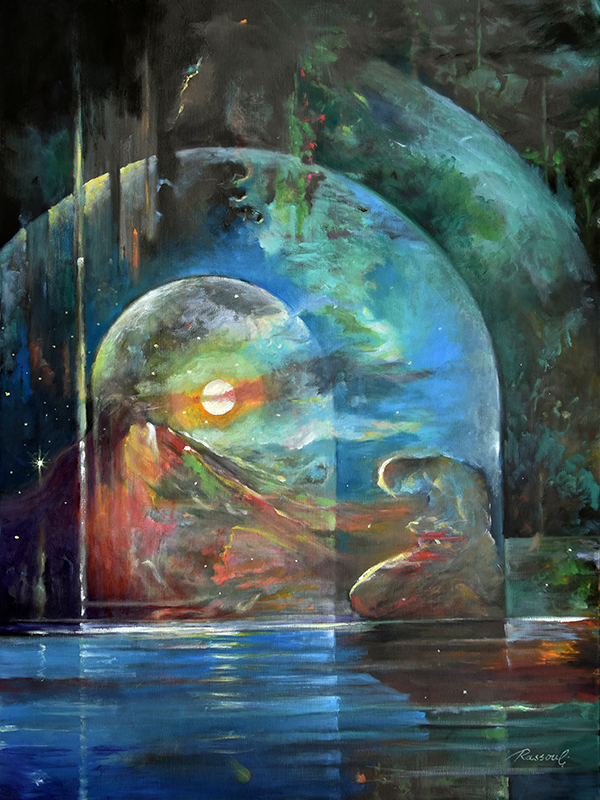
Altar of Devotion
By Rassouli
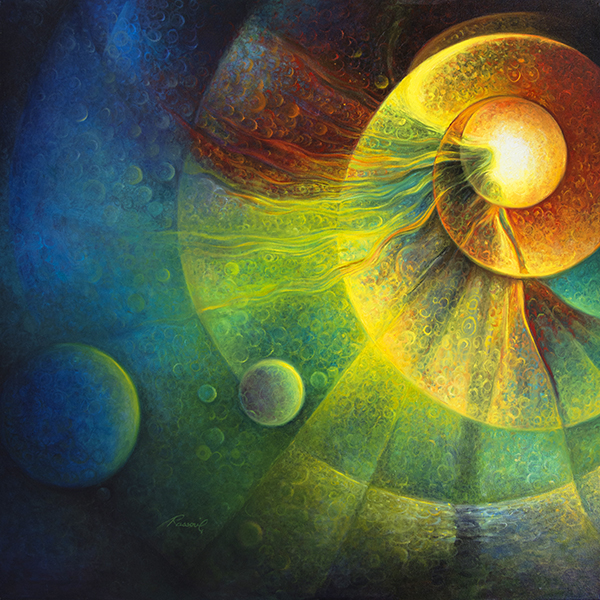
Soul's Journey By Rassouli
|

